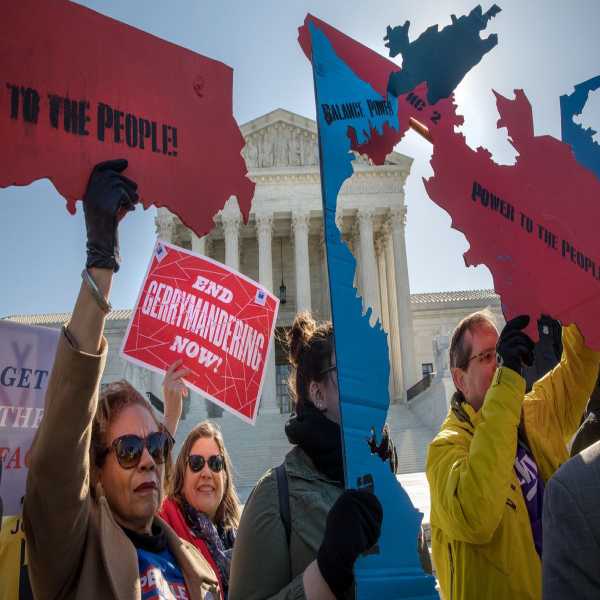The justices may have stepped away from their unrelenting hostility toward voting rights plaintiffs.

Protesters hold up cutouts of gerrymandered districts outside the Supreme Court. Evelyn Hockstein/Washington Post via Getty Images Ian Millhiser is a senior correspondent at Vox, where he focuses on the Supreme Court, the Constitution, and the decline of liberal democracy in the United States. He received a JD from Duke University and is the author of two books on the Supreme Court.
On October 11, the Supreme Court will hear a challenge to racially gerrymandered congressional maps in South Carolina that could tell us a lot about where the Court stands on voting rights.
The lower court in this case, known as Alexander v. South Carolina State Conference of the NAACP, determined that the state’s Republican legislature excluded Black voters from the state’s First Congressional District in order to shore up Republican control of that district.
The stakes in any congressional gerrymandering case are high because these cases can potentially impact who will control the US House of Representatives in the future. And the Court’s ultimate decision in Alexander may be unusually significant.
For years, the Supreme Court’s Republican majority had been almost unrelentingly hostile toward voting rights plaintiffs, and especially toward the Voting Rights Act — a federal law that bans race discrimination in elections. But in a surprising move last June, the Court struck down an Alabama gerrymander, affirming a lower court decision holding that the state violated the Voting Rights Act when it drew congressional maps that diluted Black voting power within that state.
Notably, the Court’s 5-4 decision in that case, known as Allen v. Milligan (2023), was written by Chief Justice John Roberts, and it rested upon a provision of the Voting Rights Act that Roberts unsuccessfully pushed President Ronald Reagan to veto when he was a young political appointee in the Justice Department.
So Milligan is potentially the first sign that the Court’s hostility toward voting rights plaintiffs is diminishing. Now, with Alexander, the first major voting rights case the Court has taken up since, we could see how committed to that pivot the justices actually are.
Technically, the legal issue in Alexander is distinct from the one in Milligan. Milligan held that Alabama violated the Voting Rights Act when it drew its congressional maps, while the lower court in Alexander held that South Carolina violated the Constitution’s safeguards against race discrimination, which function quite differently in racial gerrymandering cases.
But this Court rarely troubles itself with legal formalisms when it decides voting rights cases. Its decision in Shelby County v. Holder (2013), for example, declared a key provision on the Voting Rights Act unconstitutional based on something called the “‘fundamental principle of equal sovereignty’ among the States” that cannot be found anywhere in the text of the Constitution. The Court’s decision in Brnovich v. DNC (2021) simply made up a bunch of new limits on the Voting Rights Act, such as a presumption that voting restrictions that were commonplace in 1982 are valid, which also have no basis in any legal text.
This is why the Milligan decision, which hewed to a 37-year-old precedent governing vote dilution cases, was so surprising. The Court took an unexpected turn toward following existing law.
Thus, the biggest question in Alexander is whether Milligan’s turn toward the rule of law in voting rights cases is merely a fluke or whether it reflects a broader shift in the Court’s posture toward democracy.
So what’s the legal issue in Alexander?
In 2018, former Rep. Joe Cunningham, a Democrat, won a narrow victory in South Carolina’s First Congressional District, a district that had been held by Republicans for many years. Although he lost his seat to Republican Nancy Mace in 2020, Cunningham still received over 49 percent of the vote in that election — a result which suggested that the First District would remain competitive unless it was altered.
And so the state’s Republican legislature decided to alter it. As the lower court opinion striking down this district’s new configuration explained, “when the South Carolina House and Senate began considering congressional reapportionment in 2021, the Republican majorities in both bodies sought to create a stronger Republican tilt” in this district. And the newly drawn district does appear to be more solidly Republican. Mace won her most recent election, in 2022, with nearly 57 percent of the vote.
Yet, while the GOP’s goal was to shore up Republican control of the First District, the lower court determined that it did so through an illegal racial gerrymander. Specifically, the lower court found that South Carolina’s mapmakers chopped up Charleston County, including many white voters from that county in the First District, while excluding nearly 80 percent of Charleston’s Black population.
Because South Carolina’s voters are racially polarized — in 2020, 90 percent of Black voters in South Carolina voted for President Joe Biden, according to CNN exit polls — Republicans could use race to identify which voters are likely to prefer Democratic candidates. According to the lower court, they then excluded many Black voters from the First District in order to keep them from electing a Democrat in that district.
This violates the Supreme Court’s decision in Cooper v. Harris (2017), which held that “the sorting of voters on the grounds of their race remains suspect even if race is meant to function as a proxy for other (including political) characteristics.”
South Carolina does spend some of its brief suggesting bold new limits on constitutional challenges to racial gerrymanders — at one point, for example, it implies that courts should be forbidden from ruling that a map is unconstitutionally gerrymandered unless the plaintiffs can produce “direct evidence such as a legislator’s admission” that the map was designed to target voters of a particular race.
As a whole, however, the state’s brief focuses less on calls for a new legal regime, and mostly on calls for the Supreme Court to second-guess the lower court’s factual determination that the state sorted voters into districts because of their race. The gerrymandered map, they claim, was “race-neutral” because voters were moved out of the First District “based on their political composition and traditional criteria, not their racial composition.”
This argument should not carry much, if any, weight in an appellate court. As the Supreme Court also held in Cooper, appeals courts — including the highest Court — typically should defer to a lower court’s factual determinations. The lower court’s “findings of fact — most notably, as to whether racial considerations predominated in drawing district lines — are subject to review only for clear error.”
So, if the Supreme Court is inclined to follow existing law in the Alexander case, it will affirm the lower court’s decision to strike down the gerrymandered maps. Absent clear evidence that the lower court botched its factual determinations, those determinations may not be disturbed on appeal.
What the Court should say in its Alexander opinion
Significantly, no one questions that South Carolina Republicans gerrymandered the First District to prevent Democrats from winning it again. Indeed, South Carolina repeatedly admits in its brief to the justices that “the Republican-controlled General Assembly’s goal was to ‘create a stronger Republican tilt’ in District 1.”
Under the Court’s First Amendment decisions, which protect against attempts to discriminate against voters because of their partisan affiliation, this admission should be fatal to South Carolina’s case. But the Court has never ruled explicitly that those protections apply to gerrymanders. And then there is the Court’s decision in Rucho v. Common Cause (2019), which held that federal courts typically are powerless to do anything about partisan gerrymandering. So the state’s admission that it drew a partisan gerrymander most likely will not kill South Carolina’s hopes.
To be clear, cases like Cooper establish that federal courts may sometimes intervene when states draw racial gerrymanders, meaning that voters were sorted because of their race. But cases challenging partisan gerrymanders — maps that sort voters based on whether they are Democrats or Republicans — will typically be dismissed by federal courts thanks to Rucho.
In Alexander, the lower court determined that South Carolina’s First District is both a racial gerrymander and a partisan gerrymander. And, under Cooper, federal courts should still strike down an illegal racial gerrymander even if the map wasn’t motivated by outright white supremacy, but merely by a partisan desire to use race to determine which voters are Democrats and diminish the power of those voters.
Nevertheless, South Carolina’s primary legal strategy in Alexander is simply to deny that race played any role in its map-drawing decisions, and to present the First District as the product of a purely partisan gerrymandering process.
Notably, however, the Supreme Court has never held — not in Rucho or in any other case — that partisan gerrymandering is constitutional. To the contrary, the Court has consistently held that the First Amendment protects against “viewpoint discrimination,” which occurs when the government discriminates based on someone’s political views.
Though the full Court has never struck down a partisan gerrymander for engaging in viewpoint discrimination, at least five justices have, at various times, endorsed the view that such gerrymanders violate the First Amendment. As Justice Elena Kagan wrote in her Rucho dissent, the First Amendment “gives its greatest protection to political beliefs, speech, and association,” but partisan gerrymanders “subject certain voters to ‘disfavored treatment’ — again, counting their votes for less — precisely because of ‘their voting history [and] their expression of political views.’”
So, by admitting that it drew the First District to give an advantage to Republicans and a disadvantage to Democrats, South Carolina confessed in a brief to the Supreme Court that it violated the First Amendment.
Rather than holding that the First Amendment permits viewpoint discrimination in redistricting, Rucho held that federal courts should stay away from partisan gerrymandering cases because they are too hard. As the Court said in that case, the justices have “struggled without success over the past several decades to discern judicially manageable standards for deciding” partisan gerrymandering cases. That is, the majority in Rucho concluded that it is too difficult to come up with a unified theory of partisan gerrymandering that will allow judges to determine whether each map drawn by a state legislature violates the Constitution.
Whatever the wisdom of this decision in Rucho, however, it makes no sense to apply Rucho to cases where a state openly confesses, in a brief to a court of law, that they violated the First Amendment by drawing a partisan gerrymander — for the same reason that it is not hard to figure out who robbed a bank after the bank robber shows up at the police station with a signed confession.
Is this Supreme Court likely to agree with this argument? No, it is not. Even before Rucho, states frequently defended themselves against racial gerrymandering suits by claiming that their gerrymandered maps were drawn for partisan and not racial reasons. And this Supreme Court has shown little interest in pushing back against this practice.
South Carolina can still lose, even if the Supreme Court does not move against partisan gerrymandering
Though the Supreme Court is unlikely to order states to stop defending against racial gerrymandering allegations by confessing to partisan gerrymandering, that doesn’t mean that South Carolina is likely to prevail in this case.
Again, under Cooper, it is already illegal for a state to use race as a proxy to identify Democratic voters. And the Supreme Court is supposed to defer to a trial court’s factual determination that South Carolina did, in fact, use race as such a proxy in the Alexander case.
Prior to Milligan, voting rights advocates would still have very good reason to fear the outcome of the Alexander case. As cases like Shelby County and Brnovich suggest, this Supreme Court does not always concern itself with what the law actually says when it decides a voting rights case.
But, at the very least, Milligan reveals that at least five justices are still open to the argument that the Court should strike down racially gerrymandered maps if those maps violate existing law.
Sourse: vox.com






